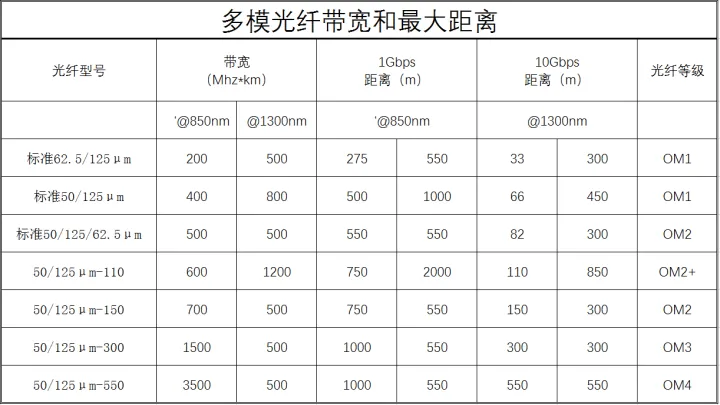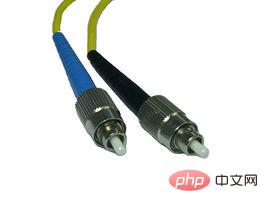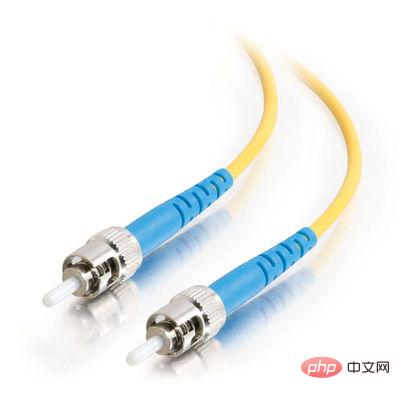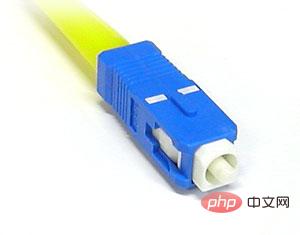What types of fiber optic interfaces are there?
The optical fiber interfaces include: 1. FC interface, the shell material is made of metal, and the interface has threads, which can be fixed well when connected to the optical module; 2. ST interface, the material is metal, and the interface is snap-on. , often used in optical fiber distribution frames; 3. SC interface, made of plastic, push-pull connection, the interface can be stuck on the optical module, often used in switches; 4. LC interface, made of plastic, used to connect SFP optical modules, interface It can be stuck on the optical module; 5. PC interface, microsphere grinding and polishing; 6. APC interface, 8 degree angle and microsphere grinding and polishing.

The operating environment of this tutorial: Windows 7 system, Dell G3 computer.
Nowadays, a large number of optical fibers are used for the wiring of the backbone part of LAN projects. The characteristics of optical fibers make the links of optical fiber interfaces complex and professional. Since there are many types of interfaces for fiber optic equipment, we are at a loss when choosing. Let’s introduce the types of fiber optics and various common fiber optic interfaces.
Optical fiber is the abbreviation of optical fiber. It is a fiber made of glass or plastic. It uses the principle of total reflection of light and can be used as a medium for light propagation. The idea that light can be used to transmit communications was proposed by former presidents of the Chinese University of Hong Kong, Kao Kun and George A. Hockham, for which Kao won the 2009 Nobel Prize in Physics.
Generally, optical fibers are divided into two types according to different transmission modes: multimode optical fiber (MMF) and single-mode optical fiber (SMF). The so-called "mode" refers to a beam of light entering the fiber at a certain angle. Single-mode fiber uses solid-state laser as the light source, while multi-mode fiber uses light-emitting diodes as the light source. Multimode fiber allows multiple beams of light of the same wavelength to propagate simultaneously in the fiber, thereby forming mode dispersion (because each beam of light enters the fiber at a different angle, the time it takes for each beam of light to reach the other endpoint is also different. This feature is called Mode dispersion.) Due to the characteristics of mode dispersion, the bandwidth and distance of multi-mode optical fiber transmission will be limited. Therefore, multi-mode optical fiber has a thick core wire, short transmission distance, and poor overall transmission performance, but the cost is relatively low and is generally used in construction. within an object or in a geographically adjacent environment. Single-mode fiber can only allow one beam of light of the same wavelength to propagate (it can transmit multiple beams of light of different wavelengths at the same time, that is, wavelength division multiplexing), so single-mode fiber has no mode dispersion characteristics. Therefore, the core of single-mode fiber is correspondingly longer. Fine, the transmission distance is long, but the cost is higher. The commonly used wavelengths of multi-mode fiber are 850nm and 1300nm, and the commonly used wavelengths of single-mode fiber are 1310nm and 1550nm.
In addition, multi-mode optical fiber has 4 levels: OM1~4, which represents bandwidth and transmission distance.

Optical fiber interface, the full name is optical fiber movable connector, the International Telecommunication Union recommends defining it as: used to stably, but not permanently A passive component that connects two or more optical fibers. In optical fiber communication links, in order to achieve the goal of flexible connections between different modules and devices, a device that can make a movable connection between optical fibers is needed. Optical fiber connector is a device used for detachable connection between optical fibers. It precisely connects the two end faces of optical fibers to maximize the coupling of light energy back and forth.
Optical fiber connectors are high-precision devices that penetrate and fix optical fibers into the support sleeve of the plug. After grinding or polishing the mating port, alignment is achieved in the sleeve coupling tube. The sleeve used for coupling alignment of the plug is generally made of ceramic, fiberglass, reinforced plastic or metal. In order to align the optical fibers, this type of connection requires very high precision in the processing of plugs and couplers.
Fiber optic connectors can be divided into FC, SC, ST, LC, D4, DIN, MU, MT-R and other types according to the structure of the connector. The commonly used ones are FC, SC, ST and LC. These commonly used interfaces are introduced below.
FC interface

The full name is Ferrule Connector, which was first used in storage area networks. The shell is made of metal and has threads at the interface, which can be fixed well when connected to the optical module.
ST interface

The material is metal and the interface is snap-on, commonly used in optical fiber distribution frames
SC interface

The material is plastic, push-pull connection, the interface can be stuck on the optical module, commonly used in switches
LC interface
is made of plastic and is used to connect SFP optical modules. The interface can be stuck on the optical module
Other interfaces:
PC microsphere grinding and polishing
APC is at an 8-degree angle and microsphere grinding and polishing
MT-RJ Square shape, dual-fiber transceiver on one end (useful on Huawei 8850)
For more related knowledge, please visit FAQ Column!
The above is the detailed content of What types of fiber optic interfaces are there?. For more information, please follow other related articles on the PHP Chinese website!

Hot AI Tools

Undresser.AI Undress
AI-powered app for creating realistic nude photos

AI Clothes Remover
Online AI tool for removing clothes from photos.

Undress AI Tool
Undress images for free

Clothoff.io
AI clothes remover

AI Hentai Generator
Generate AI Hentai for free.

Hot Article

Hot Tools

Notepad++7.3.1
Easy-to-use and free code editor

SublimeText3 Chinese version
Chinese version, very easy to use

Zend Studio 13.0.1
Powerful PHP integrated development environment

Dreamweaver CS6
Visual web development tools

SublimeText3 Mac version
God-level code editing software (SublimeText3)

Hot Topics
 1377
1377
 52
52
 my country's optical fiber giant YOFC acquires RFS's German and Suzhou companies to develop the international cable market
Apr 09, 2024 am 10:40 AM
my country's optical fiber giant YOFC acquires RFS's German and Suzhou companies to develop the international cable market
Apr 09, 2024 am 10:40 AM
According to news on April 9, YOFC Optical Fiber and Cable Co., Ltd. (hereinafter referred to as "YOFC") recently acquired the German and Suzhou companies of Radio Frequency Systems GmbH (hereinafter referred to as "RFS") and held a delivery ceremony. As a provider of optical fiber preforms, optical fibers, optical cables and comprehensive solutions, YOFC mainly produces and sells various standard specifications of optical fiber preforms, optical fibers and optical cables widely used in the communications industry, as well as various types of optical modules and special optical modules based on customer needs. Optical fibers, active optical cables, submarine cables, as well as radio frequency coaxial cables, accessories and other products. In recent years, we have vigorously expanded markets such as rail transit, base station cables and devices, and power cables. According to reports, the RFS German and Suzhou companies acquired in this transaction are engaged in activities including radio frequency cables.
 What is the download speed of Gigabit fiber?
Dec 01, 2023 pm 02:50 PM
What is the download speed of Gigabit fiber?
Dec 01, 2023 pm 02:50 PM
Gigabit fiber download speed is 1000Mbps, or 125MB/s. In actual use, due to the influence of control signals, network loss, line attenuation and other factors, the real download speed will be lower than the theoretical value. The actual download speed is about 110-117MB/s, which is about 880-936Mbps. If you use a wireless connection to measure the speed, the download speed will be affected by factors such as equipment, distance, channel, etc., and generally can only reach about 20-30% of the theoretical speed. Therefore, the normal range of gigabit broadband download speed is 20-125MB/s.
 What is the difference between optical fiber to the home and network cable to the home?
Oct 21, 2022 pm 12:56 PM
What is the difference between optical fiber to the home and network cable to the home?
Oct 21, 2022 pm 12:56 PM
Differences: 1. Fiber-to-the-home means that broadband operators directly connect fiber optic cables to users' homes, while network cable-to-home connects a commonly used Category 5 network cable to users' homes. 2. Optical fiber to the home requires the use of a special optical modem provided by the operator to receive optical signals and then output the network signal through the optical modem; while the network cable to the home can be directly plugged into the computer's network card to access the Internet, or it can be connected to the switch through a network cable and router to access the Internet. 3. The bandwidth of optical fiber is exclusive. For example, 100M optical fiber broadband, then it is 100M; while the network cable to the home shares one optical fiber for the entire unit.
 Huawei strongly supports the introduction of optical fiber and the withdrawal of copper: wiring costs are reduced by 80%, and primary wiring will not be outdated for 30 years.
Jul 04, 2024 am 09:55 AM
Huawei strongly supports the introduction of optical fiber and the withdrawal of copper: wiring costs are reduced by 80%, and primary wiring will not be outdated for 30 years.
Jul 04, 2024 am 09:55 AM
According to news on July 3, at the Huawei Africa Fully Connected Conference 2024, Chen Banghua, President of Huawei’s Optical Product Line, introduced the three major trends in the optical industry in the intelligent era: “Optical Advances and Copper Retreats”, “Optical Advances and Electrical Retreats” and “Light Advances and Human Retreats”. ". Among them, in the field of "optical advancement and copper exit", Chen Banghua said that home broadband networks need to be fully fiber-optic and extend the ultimate broadband experience to every room through FTTR to achieve a ubiquitous Gigabit or even 10 Gigabit ultimate bandwidth experience. "Light advances and copper retreats" is also moving from families to parks. In the era of 10 Gigabit campus, Wi-Fi7 is indispensable. Wi-Fi7 rate support from 3Gbps to 1
 What is the difference between single mode and multimode fiber optics?
Aug 21, 2023 pm 03:02 PM
What is the difference between single mode and multimode fiber optics?
Aug 21, 2023 pm 03:02 PM
The differences between single-mode and multi-mode optical fibers are in terms of core diameter, transmission loss, transmission distance, transmission bandwidth and application scenarios. Detailed introduction: 1. Core diameter, the core diameter of single-mode fiber is very small, usually 8-10 microns, while the core diameter of multi-mode fiber is larger, usually 50-62.5 microns; 2. Transmission loss, single-mode fiber The core diameter is small, and there is only one transmission mode when the optical signal propagates, so the attenuation of the optical signal during the transmission process is small, and the transmission loss is also low. The core diameter of the multimode fiber is large, and the optical signal has multiple transmission modes, etc. .
 How many megabytes of optical fiber is the network?
Oct 27, 2022 pm 02:33 PM
How many megabytes of optical fiber is the network?
Oct 27, 2022 pm 02:33 PM
Optical fiber does not specify the number of megabytes of broadband, but only provides high-speed bandwidth capabilities such as 10Mbps, 100Mbps, and 1000Mbps. Fiber-optic broadband only propagates signals through optical fibers, and "optical cats" are installed at both ends of the optical fibers for signal conversion.
 What are the characteristics of optical fiber?
Jun 02, 2023 pm 03:20 PM
What are the characteristics of optical fiber?
Jun 02, 2023 pm 03:20 PM
The characteristics of optical fiber are: 1. Long transmission distance, the optical fiber connection distance can reach 70 kilometers; 2. Fast transmission speed, optical fiber access can provide high-speed bandwidth such as 100Mbps, 200Mbps; 3. Low loss, the manufacturing purity of the optical fiber medium is extremely high, Therefore, the loss of optical fiber is extremely low, which can reduce the number of relay stations in communication lines and improve communication quality; 4. Strong anti-interference ability. Optical fiber is a non-metallic dielectric material. It uses optical fiber as a conductive medium and is not subject to electromagnetic interference.
 What types of fiber optic interfaces are there?
Nov 08, 2022 pm 05:09 PM
What types of fiber optic interfaces are there?
Nov 08, 2022 pm 05:09 PM
Optical fiber interfaces include: 1. FC interface. The shell is made of metal and has threads at the interface. It can be fixed well when connected to the optical module. 2. ST interface. The material is made of metal and the interface is snap-on. It is often used for fiber optic wiring. rack; 3. SC interface, made of plastic, push-pull connection, the interface can be stuck on the optical module, often used in switches; 4. LC interface, made of plastic, used to connect SFP optical modules, the interface can be stuck on the optical module ; 5. PC interface, microsphere surface grinding and polishing; 6. APC interface, 8 degree angle and microsphere surface grinding and polishing.




